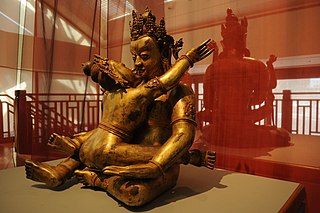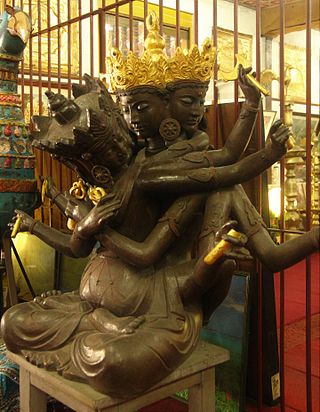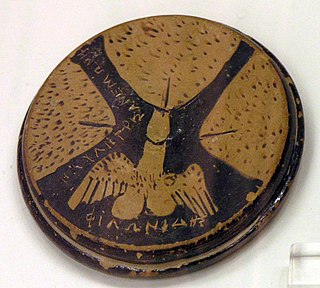Related Research Articles

Tantra is an esoteric yogic tradition that developed on the Indian subcontinent from the middle of the 1st millennium CE onwards in both Hinduism and Buddhism.

Vajrayāna, also known as Mantrayāna, Mantranāya, Guhyamantrayāna, Tantrayāna, Tantric Buddhism, and Esoteric Buddhism, is a Buddhist tradition of tantric practice that developed in the Indian subcontinent and spread to Tibet, Nepal, other Himalayan states, East Asia, and Mongolia.

Sacred prostitution, temple prostitution, cult prostitution, and religious prostitution are purported rites consisting of paid intercourse performed in the context of religious worship, possibly as a form of fertility rite or divine marriage. Scholars prefer the terms "sacred sex" or "sacred sexual rites" in cases where payment for services is not involved.

Sixty-nine or 69, also known by its French name soixante-neuf (69), is a group of sex positions in which two people align themselves so that each person's mouth is near the other's genitals, each simultaneously performing oral sex on the other. The participants are thus mutually inverted like the numerals 6 and 9 in the number 69, hence the name.

Tantric sex or sexual yoga refers to a range of practices in Hindu and Buddhist tantra that utilize sexuality in a ritual or yogic context. Tantric sex is associated with antinomian or elements such as the consumption of alcohol, and the offerings of substances like meat to deities. Moreover, sexual fluids may be viewed as power substances and used for ritual purposes, either externally or internally.
Coitus reservatus, also known as sexual continence, is a form of sexual intercourse in which a male does not attempt to ejaculate within his partner, avoiding the seminal emission. It is distinct from death-grip syndrome, wherein a male has no volition in his emissionless state.

In Buddhism, wrathful deities or fierce deities are the fierce, wrathful or forceful forms of enlightened Buddhas, Bodhisattvas or Devas ; normally the same figure has other, peaceful, aspects as well. Because of their power to destroy the obstacles to enlightenment, they are also termed krodha-vighnantaka, "Wrathful onlookers on destroying obstacles". Wrathful deities are a notable feature of the iconography of Mahayana and Vajrayana Buddhism, especially in Tibetan art. These types of deities first appeared in India during the late 6th century, with its main source being the Yaksha imagery, and became a central feature of Indian Tantric Buddhism by the late 10th or early 11th century.

Mammary intercourse is a sex act, performed as either foreplay or as non-penetrative sex, that involves the stimulation of a man's penis by a woman's breasts and vice versa. It involves placing the penis between a woman's breasts and moving the penis up and down to simulate sexual penetration and to create sexual pleasure.

Hieros gamos, hieros (ἱερός) meaning "holy" or "sacred" and gamos (γάμος) meaning "marriage," or Hierogamy, is a sacred marriage that plays out between gods, especially when enacted in a symbolic ritual where human participants represent the deities.
The great rite is a Wiccan ritual involving symbolic sexual intercourse with the purpose of drawing energy from the powerful connection between a male and female. Both receive more power. It is an uncommon ritual in a full coven, as it is used when the coven is in need of powerful spiritual intervention. Most often it is performed by the high priest and priestess of a coven, but other participants can be selected to perform the rite.
Sex magic is any type of sexual activity used in magical, ritualistic or otherwise religious and spiritual pursuits. One practice of sex magic is using sexual arousal or orgasm with visualization of a desired result. A premise posited by sex magicians is the concept that sexual energy is a potent force that can be harnessed to transcend one's normally perceived reality.

Yab-yum is a common symbol in the Tibetan Buddhist art of India, Bhutan, Nepal, and Tibet. It represents the primordial union of wisdom and compassion, depicted as a male deity in union with his female consort through the similar ideas of interpenetration or "coalescence", using the concept of Indra's net to illustrate this.

A ganacakra is also known as tsok, ganapuja, cakrapuja or ganacakrapuja. It is a generic term for various tantric assemblies or feasts, in which practitioners meet to chant mantra, enact mudra, make votive offerings and practice various tantric rituals as part of a sādhanā, or spiritual practice. The ganachakra often comprises a sacramental meal and festivities such as dancing, spirit possession, and trance; the feast generally consisting of materials that were considered forbidden or taboo in medieval India like meat, fish, and wine. As a tantric practice, forms of gaṇacakra are practiced today in Hinduism, Bön and Vajrayāna Buddhism.
Neotantra, navatantra, or tantric sexuality is a Western new religious movement influenced by the Eastern esoteric spiritual traditions of Tantra. Rooted in elements of Hindu and Buddhist tantras, neotantra blends New Age interpretations with modern Western perspectives, often emphasizing the sexual aspects of these ancient traditions. While some proponents reference traditional texts and principles, many utilize tantra as a broader term encompassing sacred sexuality, occasionally incorporating unconventional practices. However, neotantra does not always adhere to the complete range of Indian tantric practices, particularly the reliance on a guru.

Panchamakara or Panchatattva, also known as the Five Ms, is the Tantric term for the five substances used in a Tantric practice. These are madya (alcohol), māṃsa (meat), matsya (fish), mudrā (grain), and maithuna. Taboo-breaking elements are only practiced literally by "left-hand path" tantrics (vāmācārins), whereas "right-hand path" tantrics (dakṣiṇācārins) oppose these.

Armpit fetishism is a type of partialism in which a person is sexually attracted to armpits, which may lead to armpit intercourse.

A phallus is a penis, an object that resembles a penis, or a mimetic image of an erect penis. In art history, a figure with an erect penis is described as ithyphallic.

In Tibetan Buddhism, Vajravārāhī is a wrathful form of Vajrayogini associated particularly with the Cakrasaṃvara Tantra, where she is paired in yab-yum with the Heruka Cakrasaṃvara. Judith Simmer-Brown writes that "Vajravārāhī's iconography is very similar to that of Vajrayoginī, but she often has more prominent fangs and a more wrathful expression, and she prominently displays a sow's head above her right ear."
In the Buddha's first discourse, he identifies craving (tanha) as the cause of suffering (dukkha). He then identifies three objects of craving: the craving for existence; the craving for non-existence and the craving for sense pleasures (kama). Kama is identified as one of five hindrances to the attainment of jhana according to the Buddha's teaching. Throughout the Sutta Pitaka the Buddha often compares sexual pleasure to arrows or darts. So in the Kama Sutta (4.1) from the Sutta Nipata the Buddha explains that craving sexual pleasure is a cause of suffering.
If one, longing for sensual pleasure, achieves it, yes, he's enraptured at heart. The mortal gets what he wants. But if for that person — longing, desiring — the pleasures diminish, he's shattered, as if shot with an arrow.

Shmashana Adhipati is a name given to a deity either male or female and also together as a consort, who rules Shmashana, cremation ground. The Shamashana Adhipati literally translates to Lord of Shmashana. The name Shmashan Adhipathi is given to different deities in Hinduism and Tibetan Buddhism.
References
- ↑ Desmond Morris, The Naked Ape Trilogy (London 1994) p. 246 and p. 34
- ↑ Arnold van Gennep, The Rites of Passage (1977) p. 67
- ↑ Northrop Frue et al, Northrop Frye's Writing on Education (2000) p. 92
- ↑ Antony Powell, A Buyer's Market (1981 )p. 267-8
- ↑ Sigmund Freud, On Sexuality (PFL 7) p. 268-9
- ↑ Freud, Sexuality p. 269n
- ↑ G. Legman, The Rationale of the Dirty Joke Vol II (1973) p. 90-2
- ↑ Legman, Rationale p. 90
- ↑ Randall Collins, Interaction Ritual Chains (Princeton 2004) p. 235
- ↑ Margo Anand, The Art of Sexual Ecstasy (1990) p. 71
- ↑ Erving Goffman, Relations in Public (Penguin 1972) p. 235
- ↑ J. E. Douglas et al, Crime Classification Manual (2006) p. 296
- ↑ Sandra Pertot, When Your Sex Drives Don't Match (2007) p. 8
- ↑ G. Anderson/B. K. Weinhold, Connective Bargaining (1981) p. 53 and p. 58
- ↑ Mary Stewart, Airs Above the Ground (1967) p. 98
- ↑ Eric Berne, Sex in Human Loving (1970) p. 47
- ↑ Keown, Damien. (2003). A Dictionary of Buddhism, p. 338. Oxford University Press. ISBN 0-19-860560-9.
- ↑ Herrmann-Pfandt, Adelheid. "Yab Yum Iconography and the Role of Women in Tibetan Tantric Buddhism." The Tibet Journal. Vol. XXII, No. 1. Spring 1997, pp. 12-34.
- ↑ The Marriage of Wisdom and Method Archived 2011-06-17 at the Wayback Machine By Marco Pallis
- ↑ Sophie Hoare, Yoga (London 1977) p. 19
- ↑ K. Devi, in Margo Anand, The Art of Sexual Ecstasy (1990) p. 39
- ↑ Berne, p. 78-80
- ↑ Gail Sheehy, New Passages (London 1996) p. 328-9
- ↑ Watts, in Anand, p. 62
- ↑ Kate Cann, Sea Change (London 2007) p. 48 and p. 297
- ↑ Sean Thomas, the cheek perforation dance (London 2003) p. 230
- ↑ G. Blakemore Evans ed., The Riverside Shakespeare (1997) p. 229
- ↑ Amanda Hemingway, Soulfire (London 1994) p. 277 and p. 437
- ↑ C. R. Aldrich, The Primitive Mind and Modern Civilization (1999) p. 153 and p. 146
- ↑ C. G. Jung, Psychology of the Unconscious 9London 1944) p. 57
- ↑ Anand, p. 72 and p. 215
- ↑ Petronius, The Satyricon (Penguin 1986) p. 157 and p. 17